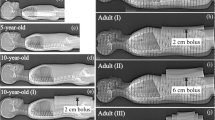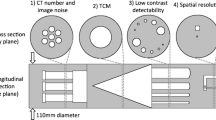Abstract
Background
For the optimum application of tube current modulation in paediatric CT it is important to know the influences of different imaging parameters on it.
Objective
This phantom study was performed to evaluate the influences of tube voltage and scan direction on combined tube current modulation, which is a combination of angular and z-axis modulation.
Materials and methods
Sixteen-slice spiral CT with combined tube current modulation was performed using four different phantoms (one adult-size anthropomorphic phantom and three cone-shaped acryl phantoms) at three different tube voltages (80, 100 and 120 kVp) and two scan directions (craniocaudal and caudocranial). Effective tube current–time product (mAs) was chosen to maintain a consistent CTDIvol for each phantom. Other parameters, including detector collimation, slice width, pitch, reconstruction algorithm, scan field of view, and scan range were identical for each phantom. Changes in CTDIvol and mAs resulting from the modulation were calculated and compared.
Results
Changes in CTDIvol and mAs resulting from the modulation were different among the three tube voltages. In larger phantoms the greatest reductions (−6.1±3.9% in CTDIvol and −12.5±4.0% in mAs) were obtained with 120 kVp, whereas in smaller phantoms they were obtained with 80 kVp (−2.8±0.9% in CTDIvol and −2.5±4.9% in mAs). Smaller CTDIvol (2.4±0.9 mGy vs. 2.5±1.0 mGy, P=0.017) and mAs (57.2±40.4 mAs vs. 61.4±43.2 mAs, P=0.002) were used in caudocranial scans than in craniocaudal scans with the modulation.
Conclusion
Combined tube current modulation is influenced by tube voltage and scan direction depending on phantom profile.





Similar content being viewed by others
References
Kalra MK, Maher MM, Toth TL, et al (2004) Strategies for CT radiation dose optimization. Radiology 230:619–628
Goo HW (2005) Pediatric CT: understanding of radiation dose and optimization of imaging techniques. J Korean Radiol Soc 52:1–5
Kalra MK, Maher MM, Toth TL, et al (2004) Techniques and applications of automatic tube current modulation for CT. Radiology 233:649–657
Mulkens TH, Bellinck P, Baeyaert M, et al (2005) Use of an automatic exposure control mechanism for dose optimization in multi-detector CT examinations: clinical evaluation. Radiology 237:213–223
Goo HW, Suh DS (2006) Tube current reduction in non-electrocardiography-gated heart CT by combined tube current modulation in children. Pediatr Radiol 36:344–351
Greess H, Lutze J, Nomayr A, et al (2004) Dose reduction in subsecond multislice spiral CT examination of children by online tube current modulation. Eur Radiol 14:995–999
Greess H, Wolf H, Baum U, et al (2000) Dose reduction in computed tomography by attenuation-based on-line modulation of tube current: evaluation of six anatomical regions. Eur Radiol 10:391–394
Das M, Mahnken AH, Mühlenbruch G, et al (2005) Individually adapted examination protocols for reduction of radiation exposure for 16-MDCT chest examinations. AJR Am J Roentgenol 184:1437–1443
Kalra MK, Rizzo S, Maher MM, et al (2005) Chest CT performed with z-axis modulation: scanning protocol and radiation dose. Radiology 237:303–308
Tack D, De Maertelaer V, Gevenois PA (2003) Dose reduction in multidetector CT using attenuation-based online tube current modulation. AJR Am J Roentgenol 181:331–334
Mastora I, Remy-Jardin M, Delannoy V, et al (2004) Multi-detector row spiral CT angiography of the thoracic outlet: dose reduction with anatomically adapted online tube current modulation and preset dose savings. Radiology 230:116–124
Greess H, Nomayr A, Wolf H, et al (2002) Dose reduction in CT examination of children by an attenuation-based on-line modulation of tube current (CARE Dose). Eur Radiol 12:1571–1576
Rizzo SM, Kalra MK, Schmidt B (2005) Automatic exposure control techniques for individual dose adaptation (letter). Radiology 235:335–336
Boone JM, Geraghty EM, Seibert JA, et al (2003) Dose reduction in pediatric CT: a rational approach. Radiology 228:352–360
Sigal-Cinqualbre AB, Hennequin R, Abada HT, et al (2004) Low-kilovoltage multi-detector row chest CT in adults: feasibility and effect on image quality and iodine dose. Radiology 231:169–174
Author information
Authors and Affiliations
Corresponding author
Rights and permissions
About this article
Cite this article
Goo, H.W., Suh, D.S. The influences of tube voltage and scan direction on combined tube current modulation: a phantom study. Pediatr Radiol 36, 833–840 (2006). https://doi.org/10.1007/s00247-006-0177-3
Received:
Revised:
Accepted:
Published:
Issue Date:
DOI: https://doi.org/10.1007/s00247-006-0177-3




